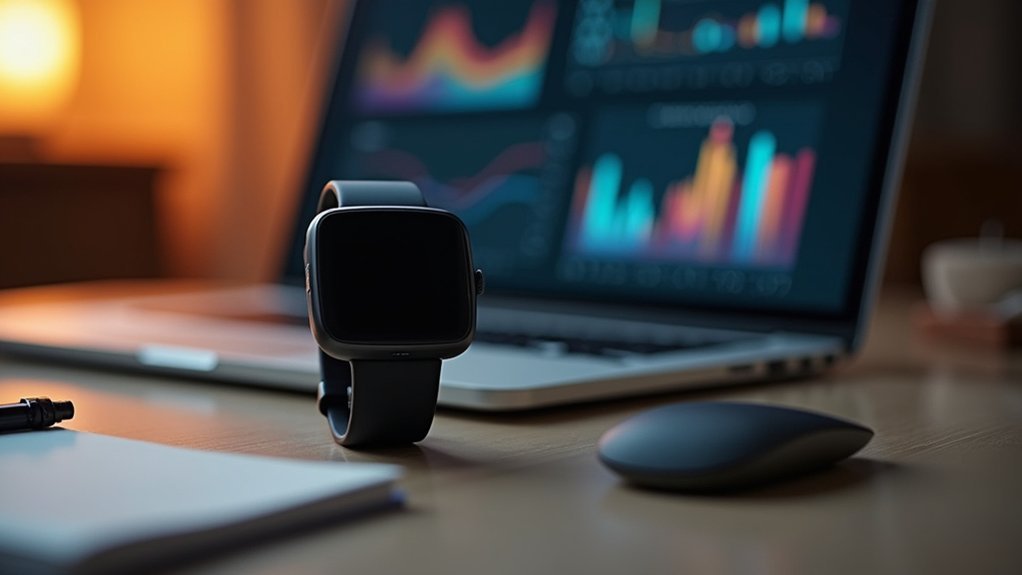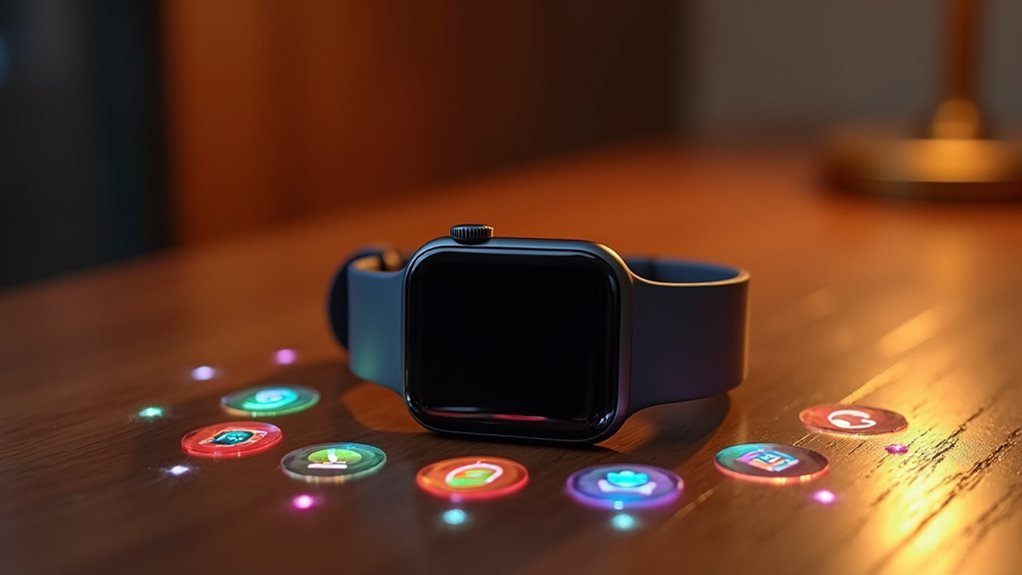Most smartwatches store your heart rate data in their companion apps, but export methods vary widely. For Apple Watch, use the Health app’s export function; Fitbit allows CSV downloads for up to 31 days; Samsung offers “Download personal data” in Samsung Health; and Garmin requires third-party tools to convert proprietary files. You’ll need to navigate device-specific settings, formats like CSV or XML, and privacy considerations for meaningful analysis of your cardiovascular patterns.
Understanding Heart Rate Data on Smartwatches

Smartwatches have revolutionized personal health tracking by constantly monitoring your heart’s activity throughout the day. These devices capture several types of cardiac data, including resting heart rate, active heart rate during exercise, and heart rate variability (HRV).
Most smartwatches use photoplethysmography (PPG) sensors that optically detect blood flow changes beneath your skin. Depending on your device, measurements occur continuously or at intervals—sometimes as frequently as every second during workouts.
Modern wearables track your pulse using light sensors, measuring blood flow patterns at regular intervals throughout your day.
Your watch then processes this raw data into useful metrics like heart rate zones (fat burn, cardio, peak) to guide your exercise intensity. Some users recommend verifying heart rate values with additional medical devices to ensure accuracy.
While convenient, it’s crucial to recognize that accuracy varies across devices and conditions, with clinical pulse oximeters serving as the gold standard for validation.
Apple Watch Heart Rate Export Methods
The health data collected by your Apple Watch becomes truly valuable when you can access and analyze it beyond the confines of your wrist.
You have two primary options for exporting your heart rate measurements.
Apple’s Health app offers direct export by tapping your profile icon and selecting “Export All Health Data.” This creates an XML file containing all your health metrics, though you’ll need to filter out heart rate data specifically. These XML files contain detailed health records, including ECGs and other vital measurements.
For more tailored exports, consider third-party apps like Heart Reports. These tools generate CSV or PDF files with detailed heart rate statistics, visualizations, and even contextual information like logged symptoms.
Many support automatic uploads to iCloud, ensuring your data remains accessible across all your devices.
Fitbit Heart Rate Data Retrieval Options

Unlike Apple’s somewhat limited export options, Fitbit provides you with several extensive methods to retrieve your heart rate data. You can export up to 31 days of recent data or a lifetime archive through the Fitbit website in CSV or Excel formats.
For more granular control, access the JSON API endpoints to retrieve detailed heart rate time series with minute-by-minute insights. You’ll need to specify date ranges using the yyyy-MM-dd format and times in HH:mm.
If you prefer automation, tools like Coupler.io can schedule regular exports directly to Google Sheets, eliminating manual effort. These scheduled exports maintain consistent data feeds for ongoing analysis. Your Fitbit data includes valuable metrics like resting heart rate which is typically around 70 bpm for most users.
Remember that all export methods require logging into your Fitbit account, and you’ll need to provide consent when using third-party services.
Samsung Galaxy Watch Health Data Transfer
To export heart rate data from your Samsung Galaxy Watch, you’ll need to use Samsung Health’s “Download personal data” option in the app settings or transfer it via Samsung Cloud.
You can integrate with third-party tools like Strava or Health Sync, though historical data transfer often requires manual export rather than automatic syncing. For more comprehensive data management, you can also generate a PDF file of your health records directly from the Samsung Health app’s export feature.
When exporting, your heart rate data typically comes in a portable format, but you’ll need to verify your Samsung account for security purposes before accessing these files.
Samsung Data Export Methods
When managing your Samsung Galaxy Watch health data, you’ll find multiple built-in options for exporting heart rate information.
Samsung Health provides straightforward paths to access your cardiac metrics through its native export features.
To export your heart rate data:
- Navigate to Health Records in the Samsung Health app, then select the export option to download extensive health data including heart rate readings.
- Access Settings → Download personal data → Download, which requires Samsung account verification but provides complete data files saved locally on your phone.
- For ECG-specific exports, open an ECG record, tap “See details,” then use the “Share this report” function to save or share your cardiac rhythm data.
Exported files typically use .GPX format and can be transferred to other devices or cloud storage for backup purposes. Unfortunately, these exports often present challenges because heart rate data is particularly difficult to extract from Samsung wearables compared to other metrics.
Third-Party Tool Integration
Samsung’s ecosystem offers four distinct pathways to export and manage your Galaxy Watch heart rate data beyond the native Samsung Health app.
You can utilize third-party apps like “Sporty Watch” that bypass Samsung Health entirely, collecting data directly from your watch and syncing to platforms such as Strava or Google Drive.
Developers can leverage the Samsung Privileged Health SDK to build custom apps that capture real-time heart rate readings from Galaxy Watch4 or newer models.
For multi-device users, enabling Samsung Cloud sync in your Health app settings guarantees data accessibility across all your Samsung devices. The data integration is enhanced when you select Sync now for immediate synchronization of your health metrics across your connected devices.
When upgrading devices, Samsung Smart Switch offers seamless data migration between Galaxy products, preserving your health records and fitness data during changes.
Each method provides unique benefits depending on your specific needs for data access and analysis.
File Format Considerations
Although Samsung Health offers robust heart rate tracking capabilities, the file formats used for data export present several challenges for users seeking to transfer their health data.
When you export your heart rate data from your Galaxy Watch, you’ll receive a combination of CSV and JSON files that aren’t readily compatible with most fitness platforms.
To understand the format limitations you’re facing:
- Samsung Health exports primarily in CSV format, which works well for Excel analysis but isn’t accepted by most fitness apps.
- Standard fitness formats like .FIT, .TCX, and .GPX aren’t supported in direct exports, limiting your ability to transfer data.
- The lack of official documentation for the exported file structure means you’ll need custom scripts or third-party tools to convert your valuable heart rate data. Many users report ongoing confusion regarding proper interpretation of the exported data elements.
Garmin Watch Heart Metrics Access
Despite their sophisticated sensors, Garmin watches don’t make accessing detailed heart rate data particularly straightforward. Your watch collects heart rate continuously, but typically stores this information in 2-minute intervals for daily tracking, not the per-second data many users desire.
To access more granular heart rate data, you’ll need to record a timed activity or enable specific settings on devices like the Fenix series.
When exporting, you’ll face the challenge of dealing with proprietary .FIT files, which require conversion tools or programming knowledge to transform into usable formats like CSV. Many users express frustration and disappointment over this complex data extraction process that lacks user-friendly alternatives.
The “Broadcast HR” function can help transmit your heart rate to other devices, potentially creating more export options.
While Garmin Connect shows a timeline view of your heart data, the platform lacks a simple button for direct CSV exports.
Third-Party Apps for Heart Data Collection

When Garmin’s native options fall short, third-party apps can greatly expand your heart rate data collection capabilities. Popular options like Strava, RunKeeper, and MapMyRun integrate with many devices, offering advanced heart rate analytics beyond default features.
Augment your Garmin with external apps to unlock richer heart rate insights and analytics.
For thorough data collection, consider these options:
- ANT+ Heart Rate Grapher – Works in the background with ANT+ monitors, providing detailed graphical representations and allowing data export for analysis.
- Strava and RunKeeper – Compatible with most devices via Bluetooth GATT, these apps store your historical heart rate data while offering community features. Some apps require you to double-press and hold the designated button to make your heart rate sensor discoverable to the app.
- Instant Heart Rate – Uses your smartphone camera for quick measurements when your watch isn’t available, plus provides stress level monitoring as a bonus feature.
Most apps require specific permissions and compatible hardware to properly access your heart rate data.
CSV vs. XML Data Format Comparison
Choosing between CSV and XML formats for your heart rate data export requires understanding their fundamental differences and use cases.
CSV offers a simple, tabular structure that’s highly readable and compatible with spreadsheet applications like Excel. You’ll find CSV files are smaller and faster to process, making them ideal for large datasets or frequent exports.
XML, however, excels with complex, hierarchical data that requires validation and rich context. While XML files are larger and more verbose due to their tag structure, they provide built-in metadata and formal validation schemas that guarantee data integrity. XML is widely used in healthcare systems for exchanging and sharing electronic health information.
For personal heart rate monitoring, CSV’s simplicity makes it perfect for direct analysis, while XML might be better if you’re integrating with healthcare systems that demand strict data validation and complex relationships.
Cloud Storage Solutions for Heart Rate History
You’ll find your heart rate history better protected through cloud backup automation that regularly syncs your data without manual intervention.
Popular wearable vendors like Apple, Fitbit, and Garmin offer their own storage solutions with varying retention periods and analysis features.
For more flexibility, you can use third-party integration solutions like Google Fit, Apple Health, or specialized fitness platforms that consolidate data from multiple devices into one secure cloud location. Both Samsung Gear S3 and Apple Watch Series 3 allow you to track health-related data comprehensively through their respective health apps.
Cloud Backup Automation
Seamless cloud backup automation revolutionizes how you maintain your heart rate data history. Your smartwatch and companion apps work together to guarantee your valuable health information is securely preserved without manual intervention.
Background processes on your smartphone handle continuous data transfers whenever you’re connected to the internet. Modern smartwatches like the Galaxy Watch 7 and Pixel Watch 3 demonstrated high correlation values during running and cycling activities in recent performance tests.
With modern backup automation, you’ll benefit from:
- Worry-free data protection – Your heart rate history automatically uploads to secure cloud servers, creating redundant backups that protect against device loss or damage.
- Verification systems – Built-in checks confirm data integrity before and after transfer.
- Cross-platform accessibility – Access your complete heart rate history from any device, making it easy to share with healthcare providers.
You’ll receive notifications when backups complete, confirming your data is safely stored and encrypted.
Vendor-Specific Storage Options
Most major fitness platforms provide proprietary cloud storage systems tailored specifically for heart rate data, each with distinct advantages and limitations. You’ll find these vendor solutions offer scalability that adjusts to your tracking needs while maintaining robust security for your sensitive health information. These platforms employ advanced analytics tools for processing the enormous volume of data collected from wearable devices.
| Platform | Storage Capacity | Key Features | Integration |
|---|---|---|---|
| Apple Health | Unlimited | Real-time analytics, encryption | Apple ecosystem, third-party apps |
| Fitbit Premium | 30-day history (free), Unlimited (paid) | Detailed trends, sleep correlation | Google Fit, partner apps |
| Garmin Connect | Unlimited | Training metrics, recovery insights | Strava, MyFitnessPal |
| Samsung Health | Unlimited | Personalized coaching, stress tracking | Galaxy ecosystem, third-party services |
When choosing a platform, consider how each solution balances security features with analytics capabilities. Many offer customizable storage options that you can adjust as your fitness tracking needs evolve.
Third-Party Integration Solutions
While vendor-specific platforms offer extensive heart rate tracking, third-party cloud storage solutions provide greater flexibility for users who prefer platform-agnostic data management.
Cloud integration centralizes your heart rate data across multiple devices and offers enhanced analytical capabilities beyond native apps.
When selecting a third-party solution, consider these key benefits:
- Scalability and flexibility – Store unlimited heart rate history without device constraints and access your data across all platforms
- Advanced analytics – Gain deeper insights through sophisticated tools that identify patterns and trends in your heart rate data
- Integration with other health metrics – Connect your heart rate information with sleep, activity, and nutrition data for thorough health monitoring
These solutions resolve cross-platform compatibility issues while providing robust backup protection for your valuable health data. Most services support integration with devices capturing high-frequency data for more detailed cardiovascular analysis.
Data Privacy Considerations for Health Metrics
As consumers increasingly rely on wearable devices to track their heart rate and other health metrics, the privacy implications have become considerably more complex.
Your smartwatch data isn’t fully protected by HIPAA unless transmitted to healthcare providers, creating significant privacy gaps.
When exporting heart rate data, remember that this sensitive information may be vulnerable to unauthorized access, misuse, or even sale to third parties without your explicit consent.
Many wearable companies lack transparency about how they use your health metrics.
The proposed Smartwatch Data Act aims to prohibit the unauthorized transfer or sale of your non-anonymized consumer health information collected from personal devices.
Protect yourself by enabling data encryption, reviewing privacy settings, and understanding third-party sharing policies before exporting data.
Recent FTC rule expansions offer some protection, but extensive safeguards remain limited.
Consider advocating for stronger regulations while practicing vigilance with your personal health information.
Analyzing Your Exported Heart Rate Patterns
Your exported heart rate data can reveal valuable patterns related to stress triggers when you compare elevated rates with your daily activities and environmental factors.
You’ll gain insights into your sleep quality by examining heart rate variability during rest periods, where lower variability often indicates better recovery.
These personalized metrics enable you to make targeted lifestyle adjustments based on how your body responds to different situations throughout the day. Utilizing machine learning algorithms can further enhance pattern recognition in your heart rate data, providing deeper insights into your health trends.
Subheading Discussion Points
How exactly can you make sense of all that heart rate data you’ve exported? The key lies in identifying patterns that reveal insights about your health and fitness. Your smartwatch data is particularly valuable during periods of lower activity, especially at night when measurements show greater consistency.
When analyzing your exported heart rate data, focus on:
- Daily consistency patterns – Compare your heart rate trends across different days to identify your personal baseline and detect unusual variations.
- Activity correlation – Examine how your heart rate responds to specific activities to gauge cardiovascular fitness and recovery times.
- Long-term trends – Track changes in your resting heart rate and HRV over weeks and months as potential indicators of improving fitness or developing health concerns. Higher variability in heart rate measurements often indicates better stress resilience and overall autonomic nervous system function.
Identifying Stress Triggers
When exported heart rate data reveals consistent spikes throughout your day, you’ve found valuable clues to your stress triggers.
By analyzing your heart rate variability (HRV), you can pinpoint moments when your autonomic nervous system shifted into stress mode.
Look for periods of decreased HRV, especially drops in high-frequency power, which indicate reduced parasympathetic activity—a telltale sign of stress.
Your smartwatch data can distinguish between acute stress (sudden HRV drops with increased heart rate) and chronic stress patterns (persistently lower HRV over time).
Export your data to specialized apps to analyze both time and frequency domains.
Pay attention to both low-frequency and high-frequency power metrics to understand your sympathetic-parasympathetic balance.
Research shows that stress-related decreases in heart rate complexity correlate with exposure to significant life events.
This analysis helps you identify specific stressors and develop targeted strategies for better stress management.
Sleep Quality Assessment
Exported heart rate data offers profound insights into your sleep quality beyond just tracking your hours in bed. Your heart’s rhythm during sleep serves as a personal health signature, with patterns that reveal your overall wellness and recovery.
When analyzing your exported sleep data, focus on these key indicators:
- Heart Rate Variability (HRV) – Higher variability typically indicates better sleep quality and stress resilience. Look for consistent HRV patterns across nights.
- Resting Heart Rate Curve – Your heart rate should naturally decrease during deeper sleep stages. Lower overall sleeping heart rates often reflect better cardiovascular fitness. Your data may reveal one of four common sleep patterns, including the Hammock, Downward Slope, Hill, or Uplands.
- Sleep Stage Shifts – Though not as accurate as clinical methods, heart rate changes can help identify shifts between sleep stages, giving you a basic understanding of your sleep architecture.
Troubleshooting Common Export Issues
Despite their advanced technology, smartwatches and fitness trackers often encounter problems when exporting heart rate data. Outdated firmware, incorrect device settings, or incomplete syncing can lead to missing heart rate information in your exports. Restarting your Apple Watch can often resolve data export issues that prevent accurate heart rate information from transferring to health apps.
| Problem | Likely Cause | Solution |
|---|---|---|
| Missing HR data | Outdated firmware | Update device and app software |
| Incomplete exports | Incorrect recording settings | Set to “Every Second” recording |
| No data in files | Format limitations | Try different export format (CSV) |
Check if your device requires specific settings like Garmin’s “Every Second” recording mode. Your export issues might also stem from privacy settings blocking data access or connectivity problems during syncing. For thorough data access, you’ll likely need to generate a complete account archive rather than relying on basic exports, as some platforms limit downloadable history to recent periods.
Combining Heart Rate Data With Other Health Metrics
The true power of heart rate data emerges when you combine it with additional health metrics, creating an all-inclusive picture of your overall wellness.
Integrating heart rate with multiple health variables unlocks the complete story of your body’s daily performance.
By integrating your heart rate information with activity, sleep, and nutritional data, you’ll gain deeper insights into your health patterns.
Modern smartwatches have evolved from simple devices to sophisticated systems with dual purpose technology that functions both as a personal assistant and comprehensive health tracker.
When exporting data from your smartwatch, look to combine heart rate with:
- Sleep metrics – Analyzing your heart rate variability during sleep provides valuable recovery insights and helps assess sleep quality.
- Activity measurements – Correlate steps, walking distance, and exercise intensity with heart rate to better understand your cardiovascular fitness.
- Physiological indicators – Pairing heart rate with oxygen saturation, skin temperature, and respiratory rate creates a thorough health monitoring system.
This integrated approach transforms isolated data points into actionable health intelligence.
Creating Custom Heart Rate Reports and Visualizations
While raw heart rate data provides valuable insights, transforming it into custom reports and visualizations reveals its full potential. You’ll need appropriate tools to effectively analyze your exported data.
| Tool Type | Popular Options | Best For |
|---|---|---|
| Programming | R, Python (Pandas) | Detailed analysis |
| Spreadsheet | Excel, Google Sheets | Quick visualizations |
| Specialized | Tableau, Power BI | Professional reports |
| Visualization | Matplotlib, Seaborn | Custom graphs |
Create custom reports by filtering data by date or activity type, and include fields like resting heart rate or zone distributions. Visualize trends with line plots for temporal patterns, bar charts for zone comparisons, and heatmaps for frequency analysis. The exported CSV files can be easily opened with common spreadsheet programs for immediate analysis. Remember to organize your data systematically and maintain regular backups to preserve your valuable health information.
Frequently Asked Questions
Can I Merge Heart Rate Data From Different Smartwatch Brands?
You can’t easily merge heart rate data from different smartwatch brands natively. You’ll need third-party utilities like GOTOES to manually combine exported files (FIT, GPX, TCX) or use direct device pairing when available.
How Often Should I Back up My Heart Rate Data?
You should back up your heart rate data after each significant workout and at least weekly for regular monitoring. Set up automatic transfers when possible and verify the data is properly saved each time.
Does Exporting Data Impact Battery Life of My Smartwatch?
Yes, exporting your heart rate data does impact battery life. You’ll notice more drain when using wireless protocols for data transfer, especially if you’re exporting continuously rather than periodically in batches.
Can Heart Rate Data Be Converted Between Different Formats?
Yes, you can convert heart rate data between different formats like CSV, XML, and HL7. You’ll find various tools like PhysioNet, scripting languages, and ECG analysis software to help with these conversions.
Are There Legal Requirements for Sharing Exported Heart Data?
Yes, you’ll need to comply with health privacy laws like HIPAA, export regulations, and data protection rules when sharing heart rate data. Always obtain consent and guarantee secure, encrypted transfers between authorized parties.
In Summary
You’ve now mastered the art of exporting your heart rate data from any major smartwatch brand. Whether you’re tracking fitness progress, monitoring health conditions, or creating detailed wellness reports, you’ll find these export methods invaluable. Don’t hesitate to combine your heart rate information with other health metrics for thorough insights. Remember, your data is most powerful when you’re actively using it to improve your well-being.





Leave a Reply